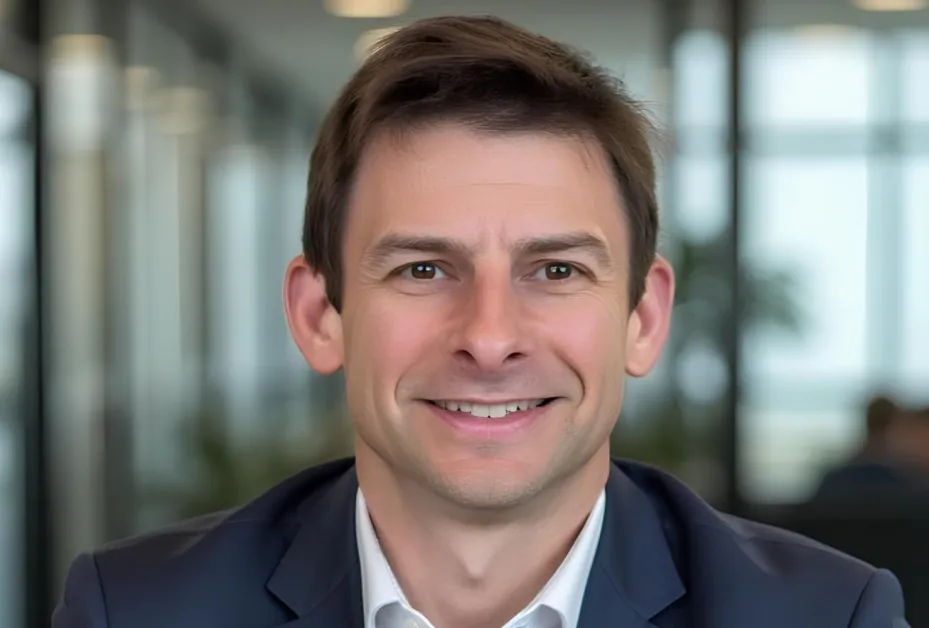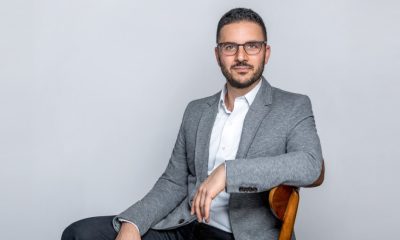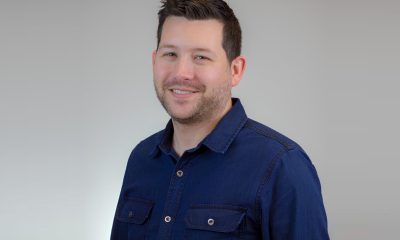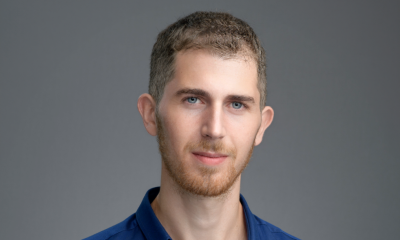Interviews
Sandy Kronenberg, CEO of Netarx – Interview Series

Sandy Kronenberg is the CEO and Founder of Netarx LLC, specializing in real-time detection of deepfake and social engineering threats across enterprise video, voice, and email. He is also Managing Partner at Koach Capital, a private equity firm focused on commercial real estate sale-leasebacks. A serial entrepreneur, Sandy previously founded a network integration and services provider acquired by Logicalis, later launched Verge.io (formerly Yottabyte) and Service.com, and served as a General Partner at Ludlow Ventures, investing in early-stage tech companies.
I started a regional Systems Integrator (SI/MSP/VAR) that I had grown to $65M in annual revenue and even though I sold the business in 2011, I have always been extremely interested in networking and cyber security advances. In the Summer of 2023 I noticed an uptick in successful social engineering attacks that were enhanced by AI/ML. After a 3rd incident occurred in as little as 2 weeks to an associate (mid-market commercial lender fell victim to wire-transfer fraud) I realized the storm was coming and began to write a patent try and help organize my thoughts.
Deepfake-related fraud is already costing enterprises hundreds of thousands of dollars per incident, yet many leaders still underestimate the risk. Why do you think executives continue to have blind spots around deepfakes and AI-driven attacks?
The persistence of executive blind spots regarding deepfakes and AI-driven attacks can be attributed to several intersecting factors, both psychological and practical.
First, there is the challenge of risk perception and normalization. For many leaders, the concept of synthetic media still feels more like science fiction than a tangible, immediate threat. This is compounded by a natural human tendency to underestimate new or unfamiliar risks, often summarized by the “it won’t happen to me” bias. Despite growing evidence of significant financial losses from deepfake-related fraud, many executives have not personally witnessed such an attack within their direct network, leading them to miscalculate its probability and potential impact on their own organization.
Second, a significant barrier is the “awareness-to-action gap.” Acknowledging a threat of this magnitude creates an immediate imperative to act. However, until recently, effective, scalable solutions for real-time deepfake detection have been unavailable. This lack of viable countermeasures can lead to a form of strategic inertia. For an executive, admitting a vulnerability without a clear path to mitigation is a difficult position. It is often easier to downplay the risk than to confront a problem for which there is no apparent solution.
Finally, there is a fundamental misconception about prevalence and form. Many leaders mistakenly believe that deepfake attacks are rare, complex operations that only target high-profile individuals. In reality, the tools for creating synthetic media are widely accessible, and attacks are already occurring at various levels within organizations, often in subtle forms like voice vishing or manipulated email communications. Because these incidents are not always publicly disclosed and can be miscategorized as standard social engineering, executives remain unaware that their organizations are likely already being targeted. This undercurrent of continuous, low-level attacks goes largely unnoticed, creating a dangerously false sense of security at the leadership level.
We’re seeing a shift from single-modal attacks (e.g., email phishing) to multi-modal campaigns that combine voice, video, and text over weeks or months. How serious is this escalation, and what makes these multi-modal attacks so difficult to defend against?
The escalation from single-modal attacks to multi-modal campaigns represents a paradigm shift in the threat landscape, and its seriousness cannot be overstated. These campaigns are fundamentally more dangerous because they exploit the seams between traditional, siloed security systems while simultaneously manipulating human trust over extended periods.
Several factors make these attacks exceptionally difficult to defend against:
- Circumvention of Point Solutions: Traditional cybersecurity is structured around defending individual channels. An organization might have a robust email security gateway, a separate solution for network traffic, and perhaps endpoint protection. Multi-modal attacks are designed to bypass these defenses by shifting from one channel to another. A threat actor can initiate contact via a benign-looking email, follow up with a social media connection, transition to a series of text messages, and culminate the attack with a highly convincing deepfake voice call. Each step, viewed in isolation by a point solution, may not trigger an alert. The true malicious intent is only visible when the entire sequence is analyzed, which most security stacks are not equipped to do.
- Sophisticated Psychological Manipulation: Multi-modal attacks are not just technologically advanced; they are exercises in long-term psychological conditioning. By engaging a target across different platforms over weeks or even months, threat actors build a credible backstory and a sense of familiarity and trust. This persistent, low-and-slow approach lowers the target’s cognitive defenses, making them far more susceptible to manipulation when the final, critical request is made. A deepfake video call from a supposed “long-term business contact” is far more likely to succeed than an unexpected one from an unknown source.
- Lack of Cross-Channel Correlation: The primary technical challenge is the absence of a unified system for correlating activity across disparate communication channels in real time. An email security platform does not communicate with a telecommunications system, and neither is typically integrated with enterprise video conferencing tools. Without this cross-channel awareness, it is impossible to connect the dots and identify a coordinated campaign as it unfolds. Detecting a single deepfake voice call is a challenge in itself; proving it is linked to a phishing email from two weeks prior is an order of magnitude more complex. This lack of integrated context is the blind spot that attackers are now systematically exploiting.
- Erosion of Human Intuition as a Defense: For years, employees have been trained to spot the tell-tale signs of a phishing email—poor grammar, suspicious links, or an unusual sense of urgency. Multi-modal attacks, incorporating hyper-realistic voice and video, effectively neutralize this training. They bypass the rational, analytical part of the brain and appeal directly to our inherent trust in what we see and hear. When a trusted executive’s voice and likeness are convincingly replicated, an employee’s intuition becomes a liability rather than a defense mechanism.
Can you walk us through how Netarx’s technology works in practice? For example, how do you detect a synthetic voice call or a manipulated video in real time, and what role do AI models play in this process?
Netarx’s technology is engineered to replace subjective trust with objective, cryptographic proof of authenticity. Our platform operates in real time across multiple communication channels to detect and neutralize synthetic media threats. The key is to bring together these signals leveraging the shared awareness.
The process can be broken down into several key stages.
- Multi-Modal Ingestion and Analysis
Our system integrates directly into an enterprise’s communication stack—including video conferencing, image review, mobile calling & messaging text, and email. When a communication event occurs, such as an incoming call or a video meeting starting, our platform begins analysis in real time.
- For Image: We analyze the content and metadata to determine if the image has been altered in any way by AI.
- For Voice: We capture and analyze the audio stream in video conference calls for artifacts that are characteristic of AI voice synthesis. This includes examining subtle acoustic properties, frequency distributions, and phonetic inconsistencies that are imperceptible to the human ear but are tell-tale signs of a machine-generated voice.
- For Video: Our models perform real-time analysis of the video feed, looking for indicators of manipulation. This involves assessing facial movements, eye blinking patterns, skin texture, and how light and shadows interact with the subject. We also check for digital artifacts left behind by the generation or manipulation process.
- For Text/Email: We analyze the content and metadata for signs of social engineering, but more importantly, we correlate this data with voice and video interactions to build a holistic threat profile.
- The Role of Ensembles of AI Models
At the core of our detection capability are advanced, Ensembles of AI models. Unlike traditional AI, which relies on a central data repository, our learning approach allows our models to be trained across multiple, decentralized environments without ever exposing sensitive client data. We use metadata signals and compare known factors and anomalies. For example, geolocation across sources can tell us if the person is seemingly at multiple or unlikely locations.
These models serve two primary functions:
- Detection: They are trained to identify the sophisticated patterns of synthetic media. Because the generative AI landscape is constantly evolving, our models are continuously updated to recognize new synthesis techniques. This ensures our defenses remain effective against the latest threats.
- Correlation: Our AI is uniquely designed to correlate data points across different channels. It can identify if a voice on a call is linked to a user profile from a previous video conference or if an urgent email request is followed by an anomalous voice call. This cross-modal analysis is critical for detecting coordinated, multi-stage attacks that individual point solutions would miss.
- Real-Time Cryptographic Verification
Detection alone is insufficient. The foundational principle of Netarx is to provide affirmative proof of authenticity. This is where our cryptographic assurance methods come into play.
When a communication is analyzed and deemed authentic, our system relays this signal via visual indication of threat. But, this process itself must be inherently secure. We currently employ a blockchain signature service as well as unique device identification. Eventually, we will augment this process with a network of federated validators that independently verify the authenticity. This signed verification acts as an immutable record, confirming that the communication was validated as genuine at a specific point in time.
- Visual Confidence Indicators
For the end-user, this complex process is distilled into a simple, intuitive interface. We provide visual confidence indicators directly within their native applications (e.g., video conferencing software, softphone client).
- A green indicator signifies that the ensemble of AI Models has not determined the communication to have been altered and/or that the participants are known.
- An amber indicator indicates that a person may be new to you or that caution should be taken.
- A red indicator alerts the user to a high probability of communication/media manipulation, providing an immediate and unambiguous warning not to trust the communication.
In practice, this means that an employee receiving a call from a coworker will see a clear visual cue in real time, confirming whether they are speaking to the legitimate individual or a deepfake. This removes the burden of judgment from the employee and replaces it with a definitive, machine-driven verification, effectively neutralizing the threat before it can cause harm.
You’ve mentioned “quantum-proof assurance methods.” What does that mean in the context of protecting enterprises from synthetic media, and why do you see it as essential for long-term digital trust?
“Quantum-proof assurance methods,” more formally known as post-quantum cryptography (PQC), refer to cryptographic algorithms that are secure against attacks from both classical and quantum computers. This forward-looking approach to security is fundamental to establishing durable digital trust, especially in the context of verifying the authenticity of communications against synthetic media threats.
The cryptographic standards that secure most of our digital world today rely on mathematical problems that are computationally infeasible for classical computers to solve. However, a sufficiently powerful quantum computer, once developed, will be capable of breaking these current encryption standards with relative ease.
This creates two distinct problems:
- “Harvest Now, Decrypt Later” Attacks: Adversaries can capture, and store encrypted data today with the intention of decrypting it in the future once quantum computing becomes viable.
- Forgery of Digital Signatures: The ability to break current cryptographic algorithms also means the ability to forge the digital signatures used to verify identity and authenticity.
In the context of protecting enterprises from synthetic media, our assurance methods are designed to provide definitive, verifiable proof that a communication is authentic. We achieve this by cryptographically signing validated media streams in real time. This signature serves as an immutable certificate of authenticity.
The integrity of this entire system hinges on the strength of the underlying cryptography. If we were to use current cryptographic standards, the authenticity records we generate today could be forged or retroactively disputed in a post-quantum future. An adversary could, for instance, take a recording of a deepfake attack that was successfully blocked and later generate a fraudulent cryptographic signature, making it appear as if the communication was once verified as authentic. This would completely undermine the long-term evidentiary value of our system.
Why Quantum-Proofing is Essential for Long-Term Trust:
Digital trust cannot be temporary. For enterprises to operate with confidence, the systems that verify identity and authenticity must be resilient not only to present-day threats but also to future ones.
- Ensuring Permanence: By integrating PQC into our assurance framework, we ensure that the cryptographic proofs of authenticity we create are permanent and cannot be broken by future advances in computing. A communication verified as authentic by Netarx today will remain verifiably authentic indefinitely.
- Future-Proofing Digital Identity: As business processes become increasingly digital, verifiable identity is the bedrock of secure transactions. Quantum-proof assurance is not merely a feature; it is a prerequisite for any system intended to serve as a long-term foundation for digital trust.
- Maintaining Evidentiary Value: In legal, financial, and regulatory contexts, the ability to produce a non-repudiable record of a communication’s authenticity is critical. Post-quantum cryptography ensures that these records maintain their integrity and evidentiary value over the long term, protecting organizations from future disputes and liabilities.
In summary, implementing quantum-proof assurance methods is a strategic necessity. It is about building a security architecture that is resilient by design, ensuring that the trust we establish in our digital interactions today remains intact in the quantum era of tomorrow.
Many industries you’ve worked with — such as finance and healthcare — are highly regulated and extremely sensitive to fraud. How are these sectors approaching the deepfake problem, and where do you see the biggest gaps in their defenses today?
Highly regulated industries like finance and healthcare face a compound challenge when it comes to deepfake threats. Their sensitivity to fraud is amplified by strict regulatory compliance obligations (e.g., HIPAA, KYC, AML) and the immense financial and reputational damage a successful attack can cause. Their approach to the problem is evolving, but significant defensive gaps remain.
Currently, these sectors are addressing the deepfake problem primarily by extending existing security frameworks and compliance protocols.
- Enhanced Employee Training: The first line of defense has been to update security awareness programs to include information about deepfakes, vishing, and sophisticated social engineering. Employees are trained to be more skeptical of urgent or unusual requests, even if they appear to come from a legitimate source.
- Strengthening Multi-Factor Authentication (MFA): Organizations are reinforcing MFA protocols for accessing sensitive systems and authorizing high-value transactions. The idea is that even if an attacker can impersonate an executive, they still need to bypass a separate authentication step.
- Procedural Safeguards: Many financial institutions are implementing stricter, manual callback procedures for large fund transfers. If an executive requests a wire transfer via video call or voice, policy dictates that the employee must hang up and call back on a pre-verified phone number to confirm the request.
While these measures are logical first steps, they are insufficient for countering advanced, AI-driven attacks and leave critical gaps in their defenses.
- Over-reliance on Human Judgment: The primary gap is a continued dependence on human employees to be the final arbiters of authenticity. Employee training is essential, but it is not a scalable or reliable defense against hyper-realistic synthetic media designed to bypass human intuition. In high-pressure situations, procedural discipline can fail, and a convincing deepfake can easily override an employee’s training.
- Lack of Real-Time, In-Band Detection: Existing security stacks in finance and healthcare lack the capability to detect synthetic media in real time, during a live communication. Procedural safeguards like callback verification happen after the initial interaction, creating a window of vulnerability. Furthermore, these out-of-band procedures are inefficient and introduce friction into legitimate business operations. There is no mechanism to warn an employee during a call or video meeting that they are interacting with a deepfake.
- Siloed Communication Channels: Like most enterprises, these sectors suffer from a lack of cross-channel threat correlation. A fraudulent process might begin with a seemingly innocent email, move to a series of text messages to build rapport, and culminate in a deepfake voice call to authorize a transaction or request patient data. Their siloed security tools analyze each of these events in isolation, completely missing the orchestrated nature of the attack.
- Compliance vs. Security: A significant gap exists between meeting regulatory compliance and achieving genuine security. An organization can be fully compliant with existing regulations but remain completely vulnerable to a multi-modal deepfake attack because current compliance frameworks were not designed to address AI-driven impersonation. This creates a false sense of security where leadership believes their compliance posture equates to adequate protection.
One challenge with cybersecurity solutions is adoption. How do you ensure that Netarx’s defenses integrate seamlessly into existing enterprise workflows without creating friction for employees?
Frictionless adoption is a core design principle of the Netarx platform. We recognized from the outset that a security solution is only effective if it is actively used and does not hinder productivity. For that reason, our approach is centered on integrating our defenses into the background of existing enterprise workflows, making security both powerful and invisible.
We ensure seamless integration through three primary strategies:
1. Frictionless SaaS Deployment Without Coding Requirements
Netarx’s architecture is delivered as a Software-as-a-Service (SaaS) platform that requires no additional coding, custom development, or the allocation of dedicated IT staff for integration. This is critical for several reasons:
- Simplified Adoption: Organizations can quickly adopt advanced multi-modal deepfake detection without undergoing complex software development projects. The solution integrates seamlessly with existing communication tools and workflows.
- Reduced Deployment Time: Because there is no need for custom coding or deep technical configuration, enterprises can deploy defenses rapidly often in a matter of minutes, hours or a few days without waiting for lengthy implementation cycles.
- Accessibility for All Organizations: Not every organization has a large, specialized IT team. By eliminating coding and dev requirements, Netarx makes sophisticated, real-time security accessible to a broad range of enterprises, including those with limited technical resources. This democratizes advanced protection in an environment where the threat landscape evolves faster than most in-house teams can respond.
- Lower Total Cost of Ownership: A no-code SaaS approach minimizes operational overhead, reduces maintenance burden, and eliminates hidden development costs, ensuring that resources remain focused on core business operations rather than continuous technical upkeep.
2. Intuitive and Unambiguous User Experience
When user interaction is necessary, it is designed to be instantaneous and require zero cognitive load. The goal is to provide clear guidance, not to create another decision point for the employee.
- Real-Time Visual Indicators: The primary user-facing component of our system is a simple set of visual confidence indicators (e.g., a green checkmark for verified, a red warning for detected threats). These icons are embedded directly into the communication interface. An employee on a video call or softphone sees immediate, unambiguous feedback about the authenticity of the person they are speaking with. They do not need to interpret complex data or follow a multi-step verification process; the system provides a clear “trust” or “do not trust” signal.
3. Elimination of Manual, High-Friction Processes
By automating the verification of authenticity, Netarx removes the need for inefficient and disruptive manual security procedures.
- Automating Callback Verification: Many organizations rely on manual callback procedures to confirm high-risk requests, such as fund transfers. This process is slow, prone to error, and disrupts normal business operations. Our platform automates this verification in real time during the initial communication. This allows legitimate business to proceed without delay while reliably stopping fraudulent requests, thereby reducing operational friction.
In summary, our philosophy is that the most effective security is felt but not seen. By integrating deeply into the existing technology stack and providing clear, automated guidance, we empower employees to operate securely without burdening them with additional tasks or complex tools. This frictionless approach is critical for driving enterprise-wide adoption and ensuring that our defenses are effectively utilized.
Looking ahead, how do you expect the deepfake threat to evolve over the next five years, and what role do you see Netarx playing in helping enterprises maintain digital trust in the synthetic media era?
The deepfake threat is not static; it is evolving at the same pace as generative AI itself. Over the next five years, we anticipate a significant escalation in the sophistication, accessibility, and scale of these attacks.
Expected Evolution of Deepfake Threats
- Hyper-Realistic Real-Time Synthesis: The quality of deepfakes will continue to improve to the point where even advanced forensic analysis will struggle to distinguish them from reality. The most significant development will be the proliferation of real-time voice and video synthesis. This will enable attackers to conduct interactive, live conversations using a victim’s likeness, moving beyond pre-recorded messages to dynamic, two-way impersonation during video conferences and phone calls.
- Autonomous, AI-Driven Campaigns: We will see the emergence of fully autonomous attack campaigns orchestrated by AI. These systems will be capable of identifying targets, gathering data from public sources, and executing multi-modal social engineering sequences without human intervention. An AI could initiate contact via email, conduct follow-up interactions over weeks, and then launch a deepfake call to achieve its objective, all while learning and adapting its tactics in real time.
- Democratization of Attack Tools: The barrier to entry for creating deepfakes will continue to fall. What currently requires some technical skill will soon be achievable through simple, user-friendly applications, possibly offered as “Deepfake-as-a-Service” on the dark web. This will lead to a dramatic increase in the volume of attacks, targeting not just large corporations but small and medium-sized businesses as well.
- “Virtual Kidnapping” and Personalized Extortion: We foresee a rise in highly personal and emotionally manipulative attacks. For example, attackers could use deepfake technology to simulate a video call from a traveling executive’s family member in distress to extort money or corporate credentials. These hyper-personalized threats are designed to trigger an emotional response that bypasses rational judgment and security protocols.
The Role of Netarx in Maintaining Digital Trust
As these threats evolve, Netarx is positioned not just to react but to proactively establish and maintain digital trust. Our role will be to provide the foundational infrastructure for authenticity in the synthetic media era.
- Pioneering a “No Trust Needed” Model for Communications: Our fundamental contribution is to shift the security paradigm from “trust but verify” to “trust is not needed, it’s always proven.” Rather than relying on fallible human perception or detection models that are always one step behind attackers, our platform is built to provide affirmative, cryptographic proof of authenticity. We are making authenticity a verifiable attribute of every communication.
- Providing a Cross-Channel Citadel of Trust: As attacks become increasingly multi-modal, our platform’s ability to correlate data and enforce authenticity across voice, video, and text will become indispensable. Netarx will serve as the central nervous system for enterprise communications security, identifying coordinated attacks that are invisible to siloed point solutions.
- Future-Proofing Authenticity: The threat landscape of tomorrow will be shaped by technologies like quantum computing, which can break today’s encryption standards. By building our platform on a foundation of post-quantum cryptography, we ensure that the certificates of authenticity we issue are permanent and non-repudiable. This long-term vision is critical for establishing durable trust.
- Enabling Secure Business Operations: Ultimately, our role is to enable enterprises to continue operating securely and efficiently in an environment where seeing and hearing are no longer believing. By providing a reliable, real-time, and frictionless method for verifying authenticity, Netarx will empower organizations to embrace new communication technologies with confidence, knowing they have a robust defense against identity-based threats.
Beyond corporate fraud and enterprise risk, deepfakes pose broader societal threats—such as destabilizing elections, spreading misinformation, and eroding public trust in media. From your perspective, what societal harms are emerging with synthetic media proliferation, and what role should cybersecurity firms like Netarx—and even policy makers—play in countering these risks?
The proliferation of synthetic media extends far beyond corporate risk, posing fundamental threats to societal stability, democratic processes, and the very concept of shared reality. While enterprise fraud is a tangible and immediate concern, the broader societal harms are insidious and potentially more damaging in the long term.
Emerging Societal Harms
- Erosion of Public Trust and the “Liar’s Dividend”: The most significant societal harm is the erosion of trust in all forms of digital media. As people become aware that any audio or video can be convincingly faked, they may start to disbelieve authentic information. This phenomenon, known as the “liar’s dividend,” can be exploited by malicious actors to dismiss genuine evidence of wrongdoing as a “deepfake.” This undermines journalism, law enforcement, and historical records, creating a world where objective truth is perpetually in question.
- Destabilization of Democratic Processes: Synthetic media is a powerful tool for political manipulation. It can be used to create fabricated videos of candidates making inflammatory statements, impersonate officials to spread disinformation, or generate large volumes of synthetic content to sway public opinion during elections. These tactics threaten the integrity of elections by misleading voters and fomenting social division.
- Acceleration of Misinformation and Disinformation: Deepfakes serve as a potent accelerant for misinformation campaigns. Hyper-realistic videos are more emotionally resonant and shareable than text, allowing false narratives to spread rapidly across social networks. This can incite public panic, damage public health initiatives, and incite violence.
- Personalized Defamation and Harassment: On an individual level, the technology enables new vectors for severe harassment and reputational damage. Malicious actors can create defamatory content targeting private citizens, activists, or public figures, leading to profound psychological and social harm.
The Role of Cybersecurity Firms and Policymakers
Countering these multifaceted threats requires a coordinated effort between the technology sector and governing bodies. Neither can solve this problem in isolation.
The Role of Cybersecurity Firms like Netarx:
- Develop and Standardize Authentication Technologies: Our primary role is to build the tools necessary to distinguish authentic media from synthetic. At Netarx, we are focused on moving beyond simple detection to create a framework for cryptographic verification. By embedding verifiable proof of authenticity into communications at the point of creation, we can establish a technical foundation for trust. The goal is to make authenticated content the default standard.
- Provide Tools for All Forms of Organizations To Prevent Deepfake Threats: Our responsibility extends beyond serving large enterprises, governments, and media organizations. We are committed to equipping all forms of organizations—including small businesses, non-profits, and educational institutions—with accessible, effective tools to prevent deepfake-related threats. Recognizing the diverse needs and resource limitations these organizations face, our solutions are designed to be adaptable and scalable.
- For example, small businesses may require streamlined, easy-to-deploy verification tools that do not demand specialized IT expertise, while educational institutions might benefit from solutions that can be integrated into existing digital learning platforms to safeguard students and staff. Non-profits often operate with limited budgets, so we focus on delivering cost-effective and user-friendly technologies that provide robust protection without adding operational burden. By tailoring our offerings to address unique security challenges and resource environments, we enable organizations of all sizes and missions to proactively defend against deepfake attacks and maintain trust within their communities.
- Educate and Promote Awareness: Technology companies must play a role in educating the public and private sectors about the nature of these threats. This involves transparently explaining how the technology works and what its limitations are, thereby fostering a more informed and resilient society.
The Role of Policymakers:
- Establish Clear Legal Frameworks: Policymakers must create clear laws that criminalize the malicious use of deepfakes for fraud, defamation, and election interference, while carefully protecting freedom of expression. These regulations need to be specific enough to be enforceable without stifling legitimate uses of AI and synthetic media in art or entertainment.
- Promote Standards for Digital Provenance: Governments can play a crucial role in encouraging or mandating the adoption of content authentication standards, such as the C2PA (Coalition for Content Provenance and Authenticity). Such standards create a verifiable chain of custody for digital content, from capture to publication.
- Fund Research and Development: Public investment in R&D for media forensics and authentication technologies is critical. This can help accelerate the development of solutions and ensure they are widely accessible.
- Foster International Cooperation: Deepfake threats are borderless. International agreements and collaborative efforts are necessary to track and prosecute malicious actors and to harmonize regulatory approaches across different jurisdictions.
In conclusion, while cybersecurity firms can provide the technological shield, policymakers must provide the legal and regulatory framework. A combination of technological verification, clear legislation, and public education is the only viable path to mitigating the societal harms of synthetic media and preserving a trusted information ecosystem.
Netarx positions itself as the only real-time, multi-modal deepfake detection platform that replaces “trust” with cryptographic proof (using federated validators, blockchain, post-quantum secure methods, etc.). Could you explain how these technologies—like federated AI models and visual confidence indicators—work together to validate authenticity across voice, video, and email, and why this layered architecture is essential in today’s AI-driven threat environment?
The premise of Netarx is that in an AI-driven threat environment, subjective trust is an obsolete security control. Our platform is engineered to replace that fallible human element with objective, verifiable, and permanent cryptographic proof. This is achieved through a multi-layered architecture where each component serves a distinct purpose, creating a holistic system for validating authenticity across all communication channels.
Here is a breakdown of how these technologies work in concert:
Layer 1: Multi-Modal Ingestion and Federated AI Analysis
This is the detection and correlation layer. It is the first line of defense, designed to analyze communication streams in real time.
- Federated AI Models: Our AI models are the analytical engine. They are federated, meaning they learn and improve from data across our entire network without any single client’s data ever leaving their private environment. These models perform two critical functions:
- Artifact Detection: They analyze voice, video, and text data for subtle, machine-generated artifacts that indicate synthesis or manipulation.
- Cross-Channel Correlation: The AI connects disparate events across different channels. It can identify, for example, that a suspicious email was followed by a voice call from a new, unknown number, flagging the sequence as a potential multi-modal attack even if each individual event appears benign in isolation.
Layer 2: Cryptographic Verification via Federated Validators
This layer transforms detection into verifiable proof. A positive detection from the AI layer is a strong signal, but it is not sufficient for establishing definitive proof.
- Federated Validators: Once our AI models analyze a media stream, the data and its analysis are passed to a decentralized network of validators. These independent nodes algorithmically scrutinize the communication’s authenticity based on a variety of factors. This decentralized consensus mechanism prevents any single point of failure or compromise.
- Blockchain for Immutability: When the validators reach a consensus on the authenticity of a communication, a cryptographic signature is generated. This signature, along with key metadata, is recorded on a blockchain. This provides an immutable, auditable, and time-stamped record of the verification. This record is non-repudiable, meaning its integrity can be proven in perpetuity.
- Post-Quantum Secure Methods: The entire cryptographic process is built using post-quantum algorithms. This is a critical, forward-looking component that ensures the authenticity records we create today will remain secure and unforgeable even after the advent of quantum computers that can break current encryption standards.
Layer 3: User-Facing Visual Confidence Indicators
This is the final layer, designed for the end-user. It translates the complex backend processes into a simple, actionable signal.
- Real-Time Visual Cues: We embed intuitive indicators directly into the user’s communication applications (e.g., Microsoft Teams, VoIP client). A green icon signals that the communication has passed through all layers and has been cryptographically verified as authentic. A red icon provides an immediate warning of a detected threat. This removes the burden of judgment from the employee, allowing them to make a quick and accurate trust decision based on machine-driven proof.
Why This Layered Architecture is Essential
This integrated, multi-layered approach is not just beneficial; it is essential for defending against modern AI-driven threats for several reasons:
- Defense in Depth: A single layer can be fallible. An AI detection model might miss a novel attack, but the requirement for cryptographic consensus provides a second line of defense. This layered structure ensures redundancy and resilience.
- Addressing Multi-Modal Attacks: Today’s threats are not confined to a single channel. An architecture that does not have integrated cross-channel awareness and correlation, as our AI layer does, is fundamentally blind to the sophisticated, multi-stage campaigns that are becoming the norm.
- Moving Beyond Detection to Proof: Detection is a reactive process that identifies a potential threat. Proof, however, is a proactive process that establishes a positive state of authenticity. In a Zero Trust world, it is not enough to look for what is fake; you must be able to prove what is real. Our cryptographic verification layer provides this definitive proof.
- Creating Durable and Auditable Trust: By using blockchain and post-quantum methods, we ensure that the trust we establish is not temporary. The records of authenticity are permanent and auditable, which is critical for regulatory compliance, legal evidence, and long-term organizational security.
Thank you for the detailed inteview, readers who wish to learn more should visit Netarx.












